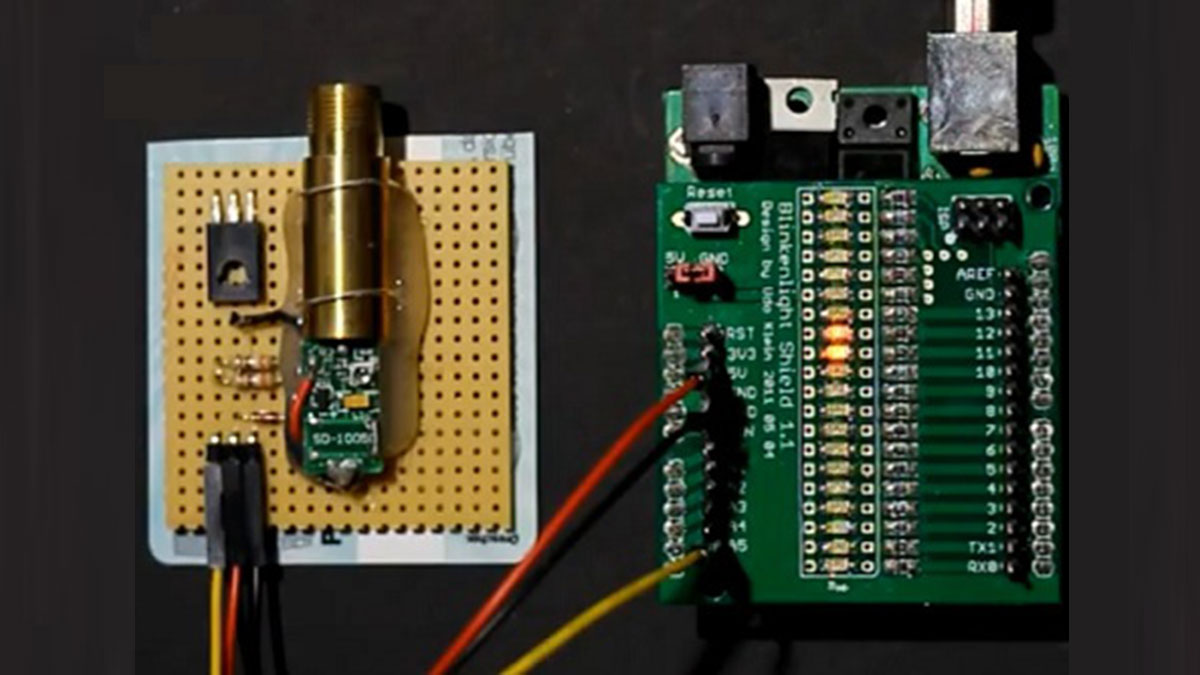Summary of Create laser range finder using arduino
The article discusses two methods to create a laser rangefinder. The first is a simple Arduino-based concept attempting to measure the speed of light using a laser pointer and timing reflections, though it faces accuracy challenges due to Arduino’s clock speed limitations. The second method involves professional rangefinder/processor modules from the 7555 and 7558 Series by AMI, which are sophisticated kits featuring high sensitivity detectors, noise tracking, digital adjustments, and cooling options, enabling precise long-distance measurements and easy integration with Arduino systems.
Parts used in the Laser Rangefinder Project:
- Arduino microcontroller
- Laser pointer
- Blinkenlight shield (light sensor)
- Mirror (for reflection)
- AMI 7555 Series Rangefinder/Processor module
- AMI 7558 Series Rangefinder/Processor module
- 758A or 755A photodetector receiver
- TE cooler controller and heatsink (7558 Series)
- Serial interface for module settings
1. TRYING TO MEASURE THE SPEED OF LIGHT WITH AN ARDUINO
We know that measuring the speed of light with an Arduino is possible. It’s just that the implementation is hard.
Last month we saw [Udo]’s blinkenlight shield that can be used as a line scan camera. It’s a neat piece of kit, but [Udo] really wants to submit something for the Buildlounge laser cutter giveaway, so he figured measuring the speed of light would be an easy project. If a kid and a chocolate bar can do it, surely it can’t be too hard.
Despite using advanced coding techniques, it is uncertain whether detecting an emitted photon is feasible with clock speeds that are relatively slow. Consider buying a few hundred meters of optic fiber so the whole experiment can be placed on a desk, but please share any alternative suggestions in the comments. The demonstration of Udo’s combination of blinkenlights and lasers can be found below.
2. LASER RANGEFINDER RECEIVERS WITH RANGE PROCESSORS
The Rangefinder/Processor assemblies in the 7558 and 7555 Series include a high-performing 758A or 755A receiver with small support electronics to deliver accurate range information to a main system. AMI’s patented technology calibrates the output of serial range data to reduce the impact of range errors caused by factors such as variations in return signal amplitude, including walk. The ability to detect very small amounts enables the use of low power lasers, or instead, operation over long distances. The modules offer high voltage bias, time programmed gain with noise tracking threshold, selection of first, last, and strongest pulses, and range gating. The 7558 line features a TE cooler controller and heatsink. There are also several user-manageable settings accessible through the serial interface. The condensed design enables placement of the optics to achieve the smallest possible system size.

- High Sensitivity down to 3nW (7558 Series)
- Fast Recovery from Overload
- Optimized for Multiple Targets
- Cooled Detector (7558 Series)
- Time Programmed Gain with Noise Tracking Threshold
- High Speed Range Counter
- Range Walk Correction to 1m RMS
- Digitally adjustable: APD Bias, Range Gates, False Alarm Rate
- Built-in HV Bias Supply for APD Detector
| Model | Detector Ø | Sensitivity (Typ) | Multiple Target Resolution (1:1 Low Gain) | Multiple Target Resolution (1:1 High Gain) | Dynamic Range | Min/Max Range |
|---|---|---|---|---|---|---|
| 7555-04 | 200µm | 5nW (20ns) | 15 meters | 30 meters | 106:1 | 50m to 65km |
| 7558-03 | 80µm | 3nW (6ns) | 10 meters | 20 meters | 107:1 | 50m to 65km |
| 7558-04 | 200µm | 5nW (6ns) | 10 meters | 20 meters | 107:1 | 50m to 65km |
Interface test board available for the Model 7555
Application Notes available for most models. Please contact us to request a copy of these ITAR controlled documents.
Specifications are typical and are subject to change without notice. See data sheet for details.
In the event these commodities will be transferred to a “foreign person” as defined in 22 CFR 120.16,either outside or within the United States, a validated US State Department license is required.
